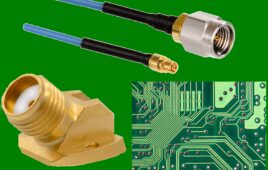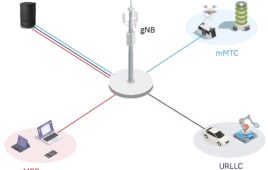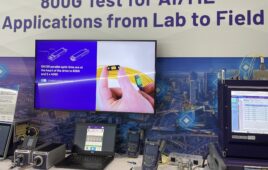Upper mid-band frequencies, above 100 GHz frequencies, and integrated sensing are some of the projects that could find their way into cellular networks.
At the 2023 NYU Brooklyn 6G Summit, EE world met with Prof. Sundeep Rangan, associate director of NYU Wireless and Peter Vetter, president of core research at Nokia Bell Labs to discuss current 6G research. Although research beyond 5G has been in the works for several years, the technologies are still coming together. Industry expectations say that standardization work will take place in the second half of the 2020 decade, much as the previous decade did with 5G. A transcript follows below the video.
Martin Rowe (EE World): Welcome to New York City. This is the Tandon School of Engineering at NYU and we are here at the Brooklyn 6G Summit 2023. I am here with Professor Sundeep Rangan, who is the director of NYU Wireless. I’m also here with Peter Vetter, who is the president of core research at Bell Labs, Nokia Bell Labs. We’re going to talk a little bit about some of the research going on that could eventually lead to 6G. I’m going to ask Professor Rangan to start. What kind of things are you working on here at the Tandon School of Engineering at NYU Wireless?
Rangan: Thanks for the opportunity to talk. By the way, I’m the associate director. We’re working on a number of projects, some of which are in collaboration with Nokia and other affiliate sponsors. We have worked a lot on some terahertz spectrum with frequencies above 100 gigahertz. I call it “tech raffle.” We’re also now looking a lot more into the upper mid-band, which is an area that a lot of carriers have been expressing an interest in. On top of that, there’s been a lot of work that Nokia has done on terrestrial networks, integration with satellites. While there have been a lot of developments in the cellular space, the satellite space has just boomed, particularly with Starlink. I think this will be a way to try to figure out how to integrate that, plus a lot of innovations in the core network itself.
So, we’re looking at areas like mobile edge computing, similar to what a lot of other people are working at here at Tandon. we have the benefit of having a lot of other users of the wireless. So we have users, for example, in robotics, professors in medical, in wearables. In all of these we’re looking at experiments and trying to understand the role of edge computing, and also a lot of those use AI services that would run through wireless networks.
How would someone in medicine might want to use this technology?
Rangan: We have a couple of projects with the School of Medicine. One is with Professor J. R. Rizzo. He builds wearables for visual assistance, he works with blind patrons. So in this case, a jacket that would have a camera on them. Then basically, you would want to use those cameras to provide visual feedback to that blind person. That requires them and also conversational AI, for example, for them to describe the scene, and to help them navigate. But these require very intensive processing because the neural networks for these are very large. So you want to run these into clouds, and then the connectivity becomes valuable. And that’s where the back end is.
And you find that cellular connectivity is what you need to make to make that happen, as opposed to, say, Wi Fi or anything else?
Rangan: People can be in any environment and that’s really anybody who uses cellular today, which is pretty much everyone with a smartphone. Of course, the benefit is that you get it everywhere. And a person who will need navigation assistance, everyone, just like you use Google Maps right now, a blind person would need something equivalent wherever they are. So that’s the benefit for somebody.
Peter, why don’t you tell us some of the research that’s going on at Nokia Bell Labs.
Vetter: At Nokia Bell Labs, we defined research for 6G, already four years ago in 2019, because we do things 10 years ahead or for the horizon of 10 years, and we expect commercial deployment in 2030. To keep it simple to remember, we defined six research directions for 6G somehow makes it easy, right? First of all, there is new spectrum technology. On one hand, is terahertz but even more importantly for us the upper mid-band. Then two, AI, probably one of the most important reasons to define a new generation, a new technology that we want to reap the benefits of AI for the automation of the network, but also AI at the air interface. Then three, use the network not only as a communications means, but also as a sense, we will have radio around us so ubiquitously. We can use radar-like technologies to get information about what’s happening in the real world. Four: extreme networking, going to specialized network requirements that go beyond the 5G ultra-reliable low latency, even 10 times better. 100 microsecond latency with reliabilities of six to nine nines. Then to really benefit from all this capability, we need a cognitive cloud network architecture. That is number five, and then six, last but not least, make that happen with security and trust.
You mentioned radar-like sensing. Can you tell us what it is? What is going on in that area and what might come out of it?
Vetter: With radio, everybody knows radar from how we detect airplanes, and how the police detect cars and even speed, right? So it’s the same technology you can actually use with signal future 6G bases. These are radio signals that are sent out, reflected back from a body and coming back. With that information, you can get information about the location of humans and objects, and even course shape, an even speed.
We’ve done a first proof of concept shown at Mobile World Congress this year (2023), where we hacked a 28 gigahertz millimeter wave system, to then detect the back reflected signal and with, say, a foot of accuracy. That localized people, but further research to come there use AI to deduce higher meanings or not only where people are, but also, there’s a certain frequency heart rate, or the object must be a mammal or human. There is a rotating fan that has a certain frequency as his signature over a piece of equipment, and even gesture recognition, I can use my arm command to the change trajectory of a drone, for instance. So there’s lots of possibilities with radio sensing. But the clue is we’re not reinventing radar to make it happen with wireless base stations that at the same time provide quality of service communication.
Sundeep do you do some of the some of that work as well?
Rangan
Definitely. I forgot to mention the sensing. One of the really valuable aspects of this sensing for radar signals, of course, unlike cameras that they can also go non-line-of-sight. So one of the projects we’re working on is for robotic navigation, where maybe a target, let’s say, a first responder needs two heads down and then needs to locate that person through their 5G signals or any other radio frequency signals that can be transmitted. We can navigate to that person, kind of an extension of a lot of localization work, which, you know, companies had already putting up significant effort in improving. So, these are super valuable services. You’re already using a lot of localization today, with Nokia and other vendors’ equipment, but these are definitely intensive.
Peter, you mentioned something about — I’ll go beyond ultra-low latency, which we’ve been hearing about for the last 10 years or so. You had talked about latency even better than what 5G was built to do. In a previous talk, you talked about something I guess you could call “machine-area networks,” or I guess you could call it “hyper local,” Maybe something like that. Can you explain, what kind of work you’re doing there?
Vetter: Yeah, so that is really cool to get to these very high reliabilities and extreme low latencies. You don’t need that in the wide area network. In, as an example, a machine area network, where machines collaborate and cooperate. There, you need these critical low latencies. In an area of 100 yards, you can achieve actually the 100 microsecond latency, you can leverage the fact that it’s short distances, you can leverage the fact that it’s low power transmission so that you can different devices that you’re exploiting there can be low power consumption also, and do a better interference cancellation. There’s other types of networks that we will see in the 6G era as well.
In machine-area networks, in car-area networks, in body-area networks, we call them generally in X, specialized local area networks. Leveraging that short-distance capability and optimizing for the spectrum latency for the specific applications. That there’s many local-area network technologies already today, like Bluetooth and Wi-Fi, but they mostly use unlicensed spectrum. The opportunity here is to really get these extreme requirements to use the licensed spectrum and optimize the operation of the local network with the wide-area network.
Do you envision these local or machine-area networks being used at millimeter wave frequencies? Higher? Lower? Where do you think they would fit?
Vetter: Conceptually, they can fit any frequency range. You’re mainly leveraging the fact that it’s local. There’s maybe only one anchored device that needs to be mobile. The other devices that are subtending don’t need to be mobile. You leverage the fact that it’s short distance, and is low power, to the other devices. Maybe there are sensitive devices that you can really exploit at nearly zero energy. So that is what you’re exploiting, the spectrum that will dictate how much bandwidth you need.
For the control, we don’t really expect the high bandwidth when it comes to two sensors, maybe yes, you need to deploy them at scale, but conceptually, any spectrum that ranges is applicable.
Sundeep, does NYU wireless collaborate with industry or with other universities? If so, how?
Rangan: NYU Wireless model works closely with a number of affiliate companies. Nokia is one of them, with several other players: Ericsson, Qualcomm, and others who are sponsoring collaborative research across this backbone in terms of industrial robotics. For example, that’s one of the projects that we definitely work on, but really at all other all parts of the stack. We’ve learned a lot from working with the industry and try to keep us focused on what problems are relevant and hopefully find some impact for the work.
All right. Well, gentlemen, thank you very much for your time, and I look forward to seeing you again. For EE world, I’m Martin Rowe. Thank you for watching.




Tell Us What You Think!